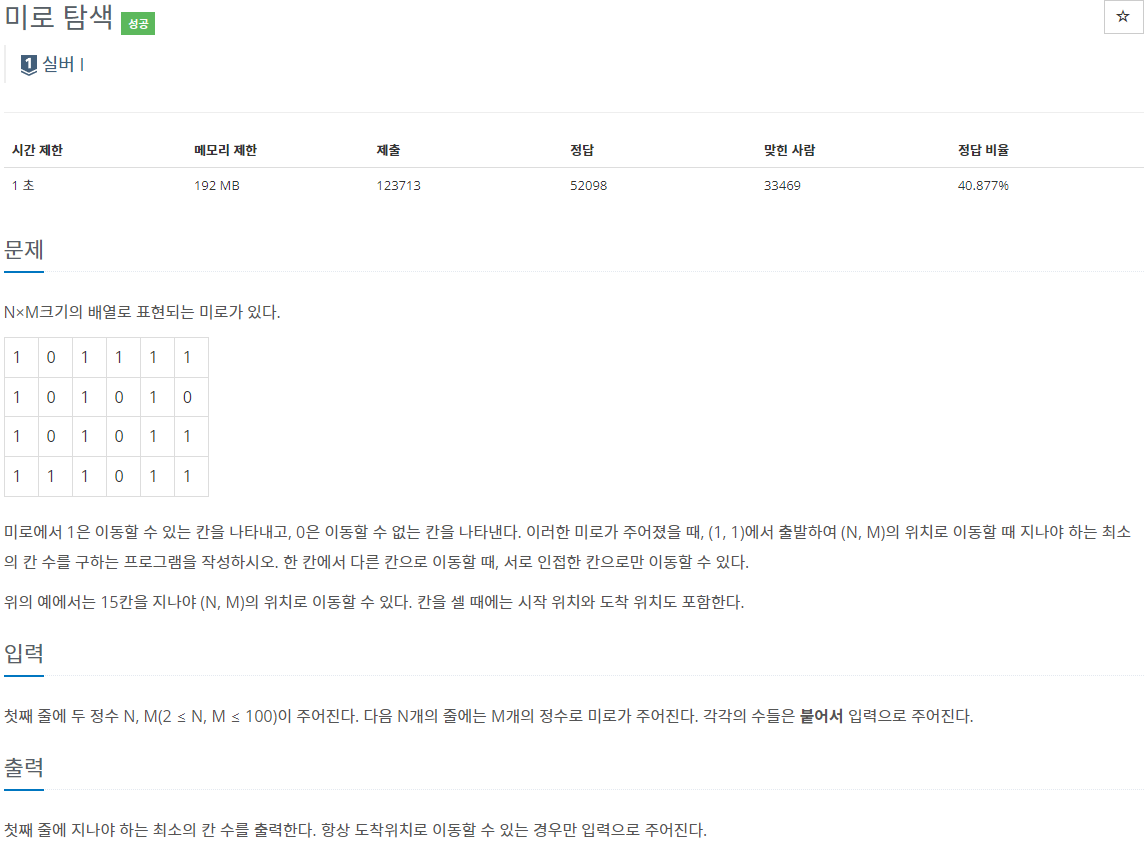6주차(DFS와 BFS) - [C++]백준2178 미로 탐색
![6주차(DFS와 BFS) - [C++]백준2178 미로 탐색](/assets/img/algorithm/main.PNG)
문제
예제 입력
코드
#include<iostream>
#include<queue>
using namespace std;
int n, m;
char map[100][100];
bool check[100][100];
int dist[100][100]; // 거리 - bfs
int dfs_ans = INT_MAX; // 거리 - dfs
int dx[] = { 0, 0, 1, -1 };
int dy[] = { 1, -1, 0, 0 };
void dfs(int x, int y, int depth) {
// 스택 이용가능 = 재귀
// 맵 범위 벗어난 경우
if (x <= -1 || x >= n || y <= -1 || y >= m) return;
if (x == n - 1 && y == m - 1) {
if (depth < dfs_ans) {
dfs_ans = depth;
}
return;
}
for (int i = 0; i < 4; i++) {
int nx = x + dx[i];
int ny = y + dy[i];
if (map[nx][ny] == '1' && check[nx][ny] == false) {
check[nx][ny] = true;
dfs(nx, ny, depth + 1);
check[nx][ny] = false;
}
}
}
void bfs(int x, int y) {
queue<pair<int, int> > q;
q.push(make_pair(x, y));
check[x][y] = true;
dist[x][y] = 1;
while (!q.empty()) {
x = q.front().first;
y = q.front().second;
q.pop();
for (int i = 0; i < 4; i++) {
int nx = x + dx[i];
int ny = y + dy[i];
if (0 <= nx && nx < n && 0 <= ny && ny < m) {
if (map[nx][ny] == '1' && check[nx][ny] == false) {
q.push(make_pair(nx, ny));
check[nx][ny] = true;
dist[nx][ny] = dist[x][y] + 1;
}
}
}
}
}
int main(void)
{
ios_base::sync_with_stdio(0);
cin.tie(0); //cin 실행속도 향상
cin >> n >> m;
for (int i = 0; i < n; i++) {
for (int j = 0; j < m; j++) {
cin >> map[i][j];
}
}
//bfs(0, 0);
//cout << dist[n - 1][m - 1];
dfs(0,0,1);
cout<<dfs_ans;
}
설명
이 문제는 미로가 주어지고 탐색을 할때 시작점에서 종료점으로 가는 최소의 칸 수를 구하는 것입니다. C++ STL(표준 템플릿 라이브러리)에서 Queue를 사용하여 구현했습니다. 미로의 형태를 입력 받아 시작점(0, 0)에서 종료점(n, m)까지 경로를 탐색하는데 BFS 또는 DFS를 변형하여 두 가지 경우로 구현했습니다. BFS는 너비우선 탐색으로 나선형 모습으로 최소의 칸으로 탐색하고 DFS는 깊이우선 탐색으로 특정 방향으로 나가는 모습으로 최소의 칸을 한 번에 못 구할 수도 있어 갱신하며 탐색을 합니다. 그리고 check값을 배정하는데 이것은 같은 곳을 탐색할 수 있는 것을 방지합니다.
-pair<자료형, 자료형> 변수명; : 하나의 변수에 2가지 값을 저장함
<queue>
-queue<자료형> 변수명; : 큐 자료구조 사용



